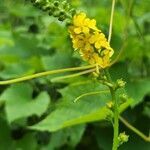Roots fibrous; stems stout, to 1 m or more, hirsute below, pubescent and glandular above; stipules lanceolate to semi-ovate, 1–2 cm; principal lfls of the larger lvs 7–11, the upper 5 commonly directed forwards, lance-ovate, coarsely serrate, glabrous or nearly so above, gland-dotted beneath and sparsely hairy, especially on the veins; axis of the infl densely pubescent with ascending hairs, commonly also with some long flexuous hairs; fls densely crowded; pedicels short, the 3-cleft bractlet commonly surpassing the hypanthium; mature hypanthium reflexed, turbinate, 4–5 mm, minutely strigose in the deep furrows; 2n=56. Dry or moist woods; Que. and N.S. to e. B.C., s. to R.I., N.Y., Mich., Io., and S.D., and in the mts. to W.Va. and Ariz.

